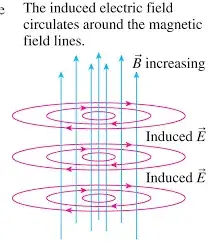I have encountered a "paradox" while studying electromagnetism and I can't seem to understand where I am messing up.
Consider a uniform, time-dependent magnetic field B(t) = $t^4 \hat{i}$ in some region of space.
By Faraday's Law, there must be some induced electric field due to the changing magnetic field. However, since the magnetic field is uniform, any two points in the space are indistinguishable, so I believe that the electric field must also be uniform everywhere in that region of space. However, if the electric field at a point is independent of its position in space, then the E field must have curl 0.
So by Faraday's Law: $\nabla \times E = -dB/dt$. However, as per my above reasoning, the left side of this equation is 0 whereas the right side will be proportional to $t^3$? How can this be?
I have a few guesses as to where I went wrong, but no justification for why they should be true:
- Maybe it is impossible to create a perfectly uniform magnetic field that increases with $t^4$? But if so, why would this be impossible?
- Although the electric field is constant (at least per my reasoning) at any instantaneous moment, that constant value will change over time since the $E$ field is proportional to $t^3$. Maybe the time dependence of the $E$-field means something?
